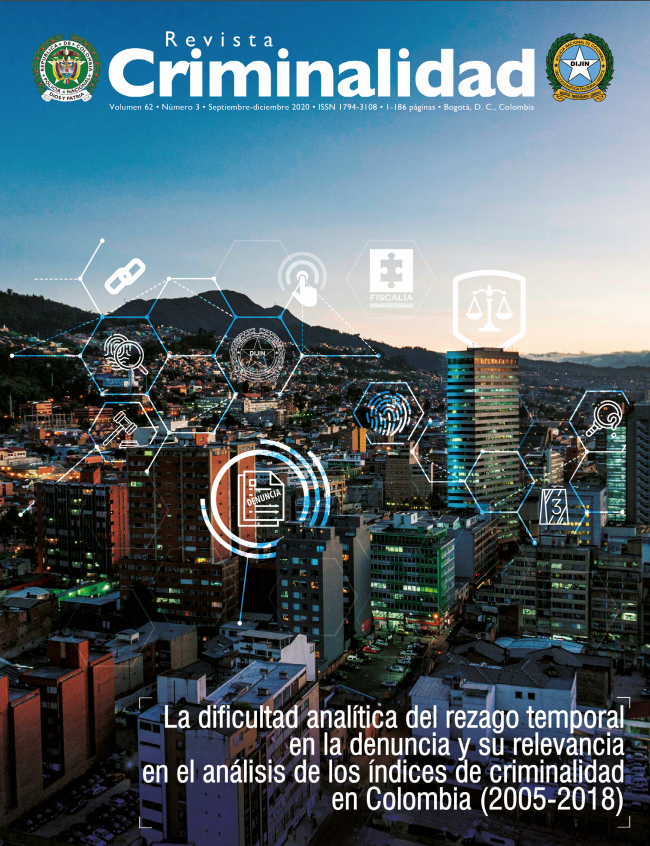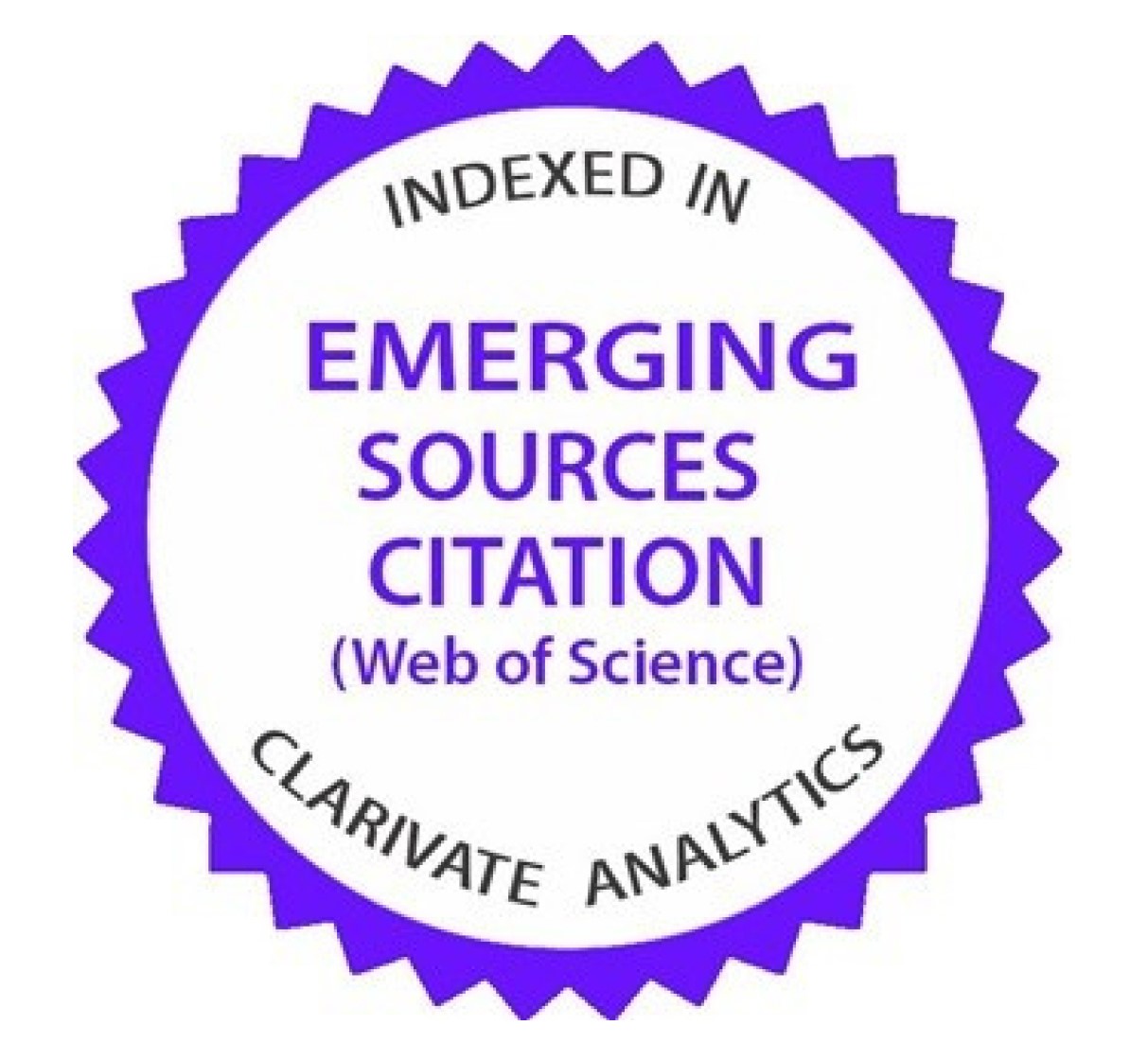Why are property crimes reported to the police? An empirical assessment for Peru
DOI:
https://doi.org/10.47741/17943108.219Keywords:
property crimes, crime reports, theft, burglary, victimizationAbstract
Peru has not only one of the highest victimization rates in Latin America (24%), but also the lowest rate of reported crimes (15%) (Latinobarómetro, 2016) The purpose of this study was to identify the characteristics of the crimes and the characteristics of the individuals that predict the decision of reporting four different property crimes (burglary, auto theft, auto parts theft, and motorcycle theft). To this end, a seven-year survey of households at the national level in Peru was used (2010-2016). The estimations were made using multilevel mixed effects logistics regression, in order to control for characteristics of the environment that also influence the decision to report. Use of a weapon by the criminal is the factor that most increases the probability of reporting any of the four assessed crimes. Repeated victimization is also an important predictor, although for a lower number of crimes. Trust in the police is not associated to the decision to report. This is the first study to quantitatively analyze the factors that affect the decision to report in Peru. Its results are useful for a better understanding of the low reporting rates in the country.
Downloads
References
Aboal, D., Campanella, J. y Lanzilotta, B. (2013). Los costos del crimen en Uruguay (IDB Working Paper Series).
Baumer, E. P. (2002). Neighborhood Disadvantage and Police Notification By Victims of Violence*. Criminology, 40(3), 579-616. https://doi.org/10.1111/j.1745-9125.2002.tb00967.x
Baumer, E. P. y Lauritsen, J. L. (2010). Reporting crime to the police, 1972-2005: A multivariate mnalysis of long-term trends in the National Crime Survery (NCS) and National Crime Victimization Survey (NCVS). Criminology, 48(1), 131-185. https://doi.org/10.1111/j.1745-9125.2010.00182.x
Benavente, J. M. y Cortés, E. (2006). Delitos y sus denuncias. La cifra negra de la criminalidad en Chile y sus determinantes. Serie Documentos de Trabajo, 228(1), 21.
Bennett, R. R. y Wiegand, R. B. (1994). Observations on Crime Reporting in a Developing Nation. Criminology, 32(1), 135-148. https://doi.org/10.1111/j.1745-9125.1994.tb01149.x
Black, D. J. (1973). The Mobilization of Law. The Journal of Legal Studies, 2(1), 125-149. https://doi.org/10.1086/467494
Boateng, F. D. (2016). Crime Reporting Behavior: Do Attitudes towards the Police Matter? Journal of Interpersonal Violence, 33(18), 2891-2916. https://doi.org/10.1177/0886260516632356
Bowles, R., García Reyes, M. y Garoupa, N. (2009). Crime Reporting Decisions and the Cost of Crime. European Journal of Crime Policy Research, 15(4), 365-77. https://doi.org/10.1007/s10610-009-9109-8
Carr, P. J., Napolitano, L. y Keating, J. (2007). We never call the cops and here is why: A qualitative examination of legal cynicism in three Philadelphia neighborhoods. Criminology, 45(2), 445-480. https://doi.org/10.1111/j.1745-9125.2007.00084.x
Chenery, S., Holt, J., y Pease, K. (1997). Biting Back II: Reducing Repeat Victimisation in Huddersfield. In B. Webb (Ed.). Crime Detection and Prevention Series Paper 82. London: Police Research Group.
Colomer, J. L. G. (2018). Policía Judicial: a la búsqueda de un modelo adecuado para una lucha eficaz contra el crimen. Cuadernos de Derecho Penal, 19, 11-46. https://doi.org/10.22518/20271743.1021
Dammert, L. (2018). Construir cuidad en contextos de alta violencia: ¿es posible? El caso del Distrito Central de Honduras. Revista Criminalidad, 60(3): 177-193.
De Ávila, W. M., & Mejía, W. B. (2019). Victimización por crimen, percepción de seguridad y satisfacción con la vida en Colombia. Revista de Economía Institucional, 21(41), 133-160. https://doi.org/10.18601/01245996.v21n41.06
Felson, R. B., Messner, S. F., Hoskin, A. W. y Dean, G. (2002). Reasons for Reporting and Not Reporting Domestic Violence To the Police. Criminology, 40(3), 617-648. https://doi.org/10.1111/j.1745-9125.2002.tb00968.x
Finkelhor, D., & Ormrod, R. (1999). Reporting Crimes Against Juveniles. In S. Bilchik (Ed.). Juvenile Justice Bulletin. Washington DC: US Department of Justice. https://doi.org/10.1037/e406792005-001
García-Sánchez, I.-M., Rodríguez-Domínguez, L., y Parra-Domínguez, J. (2011). Yearly evolution of police efficiency in Spain and explanatory factors. Central European Journal of Operations Research, 21, 31-62. https://doi.org/10.1007/s10100-011-0207-6
García, A. (2013). Factorías del crimen: México y Colombia, oleadas o persistencia de la violencia. Sociología Histórica, 2, 355-380.
Gingerich, D. W. y Oliveros, V. (2018). Police Violence and the Underreporting of Crime. Economics and Politics, 30(1), 78-105. https://doi.org/10.1111/ecpo.12102
Goldstein, H. (2010). Multilevel statistical models. West Sussex: Wiley. https://doi.org/10.1002/9780470973394
Gottfredson, D. M. y Hindelang, M. J. (1979). A Study of the Behavior of Law. American Sociological Review, 44(1), 3-18. https://doi.org/10.2307/2094813
Gottfredson, M. R., y Gottfredson, D. M. (1988). Decision Making in Criminal Justice: Toward the Rational Exercise of Discretion. New York City: Plenum Press. https://doi.org/10.1007/978-1-4757-9954-5
Goudriaan, H., Wittebrood, K. y Nieuwbeerta, P. (2006). Neighbourhood Characteristics and Reporting Crime. The British Journal of Criminology, 46(4), 719-742. https://doi.org/10.1093/bjc/azi096
Greenberg, M. S. y Beach, S. R. (2004). Property crime victims’ decision to notify the police: Social, cognitive, and affective determinants. Law and Human Behavior, 28(2), 177-186. https://doi.org/10.1023/B:LAHU.0000022321.19983.ea
Gutiérrez, C. M. y Kirk, D. S. (2017). Silence Speaks: The Relationship between Immigration and the Underreporting of Crime. Crime and Delinquency, 63(8), 926-950. https://doi.org/10.1177/0011128715599993
Hindelang, M. J., y Gottfredson, D. M. (1976). The Victim’s Decision not to Invoke the Criminal Justice Process. In W. McDonald (Ed.), Criminal Justice and the Victim (pp. 15-46). Beverly Hills: Sage.
Instituto Nacional de Estadística e Informática. (2007). Censo Nacional de Población y Vivienda. Lima: Instituto Nacional de Estadística e Informática.
Instituto Nacional de Estadística e Informática. (2016a). Censo de Comisarías. Lima:
Instituto Nacional de Estadística e Informática. Instituto Nacional de Estadística e Informática. (2016b). Encuesta Nacional de Programas Estratégicos. Lima: Instituto Nacional de Estadística e Informática.
Instituto Nacional de Estadística e Informática. (2016c). Registro Nacional de Municipalidades. Lima: Instituto Nacional de Estadística e Informática.
Jackson, J., Bradford, B., Hough, M. y Murray, K. (2012). Compliance with the law and policing by consent: Notes on police and legal legitimacy. In A. Crawford y A. Hucklesby (Eds.). Legitimacy and Compliance in Criminal Justice, (pp. 29-49). https://doi.org/10.4324/9780203113998
Kääriäinen, J. T. (2007). Trust in the police in 16 European countries: A multilevel analysis. European Journal of Criminology, 4(4), 409-435. https://doi.org/10.1177/1477370807080720
Kääriäinen, J. T. y Sirén, R. (2011). Trust in the police, generalized trust and reporting crime. European Journal of Criminology, 8(1), 65-81. https://doi.org/10.1177/1477370810376562
Khondaker, M. I., Wu, Y. y Lambert, E. G. (2017). Bangladeshi immigrants’ willingness to report crime in New York City. Policing and Society, 27(2), 188-204. https://doi.org/10.1080/10439463.2015.1040795
Kirk, D. S. y Matsuda, M. (2011). Legal Cynicism, Collective Efficacy, And The Ecology Of Arrest. Criminology, 49(2), 443-472. https://doi.org/10.1111/j.1745-9125.2011.00226.x
Kochel, T. R., Parks, R. y Mastrofski, S. D. (2013). Examining Police Effectiveness as a Precursor to Legitimacy and Cooperation with Police. Justice Quarterly, 30(5), 895-925. https://doi.org/10.1080/07418825.2011.633544
Kuo, S. Y., Cuvelier, S. J., Sheu, C. J. y Chang, K. M. (2012). Crime reporting behavior and black’s behavior of law. International Sociology, 27(1), 51-71. https://doi.org/10.1177/0268580911423054
Kury, H., Teske, R. H. C. y Würger, M. (1999). Reporting of crime to the police in the federal republic of Germany: A comparison of the old and the new lands. Justice Quarterly, 16(1), 123-151. https://doi.org/10.1080/07418829900094081
Landau, T. C. (2006). Challenging Notions. Critical Victimology in Canada. Toronto: Canadian Scholars Press.
Latinobarómetro. (2015). Informe Latinobarómetro 1995-2015. Recuperado de http://americanuestra.com/wp-content/uploads/2015/09/INFORMELB-2015-3.pdf
Latinobarómetro. (2016). Informe Latinobarómetro 2016. Santiago de Chile. https://www.latinobarometro.org/LATDocs/F00005843-Informe_LB_2016.pdf
Levitt, S. y Rubio, M. (2002). Crimen en Colombia: análisis y sugerencias de política. En A. Alesina (Ed.). Reformas Institucionales en Colombia (pp. 55-94). Bogotá: Fedesarrollo, Alfaomega.
Maguire, E., Shin, Y., Zhao, J., y Hassell, K. (2003). Structural change in large police agencies during the 1990s. Policing An International Journal of Police Strategies and Management, 26(2), 251-275. https://doi.org/10.1108/13639510310475750
Mancera, A. (2010). Factores socioeconómicos y demográficos de distintas categorías de delitos en Colombia: Prueba desde un panel de datos de las regiones de Colombia. Revista de Economía del Caribe, 2, 202-231.
Ortega, D., Mejía, D. y Ortiz, K. (2015). Un análisis de la criminalidad urbana en Colombia (Documento de Trabajo N 2015/06).
Posick, C. (2014). Victimization and reporting to the police: The role of negative emotionality. Psychology of Violence, 4(2), 210-223. https://doi.org/10.1037/a0031770
Reyns, B. W., y Randa, R. (2017). Victim Reporting Behaviors Following Identity Theft Victimization: Results From the National Crime Victimization Survey. Crime and Delinquency, 63(7), 814-838. https://doi.org/10.1177/0011128715620428
Rodríguez-Ortega, J.D., Mejía-Londoño, D., CaroZambrano, L., Romero-Hernández, M., y Campos-Méndez, F. (2018). Implicaciones del proceso de integración de los registros administrativos de criminalidad entre el SPOA de la Fiscalía General y el SIEDCO de la Policía Nacional de Colombia, y la puesta en marcha del aplicativo “¡ADenunciar!” sobre las cifras de criminalidad. Revista Criminalidad, 60(3), 9-27. http://www.scielo.org.co/scielo.php?script=sci_arttext&pid=S1794-31082018000300009&lng=en&tlng=
Skogan, W. G. (1984). Reporting crimes to the police: The status of world research. Journal of Research in Crime and Delinquency, 21(2), 113-137. https://doi.org/10.1177/0022427884021002003
Skogan, W. G. (2009). Concern about crime and confidence in the police: Reassurance or accountability? Police Quarterly, 12(3), 301-318. https://doi.org/10.1177/1098611109339893
Smith, R. y Somerville, P. (2013). The long goodbye: A note on the closure of rural police stations and the decline of rural policing in Britain. Policing: An International Journal of Police Strategies & Management Measuring, 7(4), 348-358. https://doi.org/10.1093/police/pat031
Soares, R. R. (2004). Crime Reporting as a Measure of Institutional Development. Economic Development and Cultural Change, 52(4), 851-871. https://doi.org/10.1086/420900
Tankebe, J. (2010). Public confidence in the police: Testing the effects of public experiences of police corruption in Ghana. British Journal of Criminology, 50(2), 296-319. https://doi.org/10.1093/bjc/azq001
Tarling, R. y Morris, K. (2010). Reporting crime to the police. British Journal of Criminology, 50(3), 474-490. https://doi.org/10.1093/bjc/azq011
Tolsma, J., Blaauw, J. y te Grotenhuis, M. (2012). When do people report crime to the police? Results from a factorial survey design in the Netherlands, 2010. Journal of Experimental Criminology, 8(2), 117-134. https://doi.org/10.1007/s11292-011-9138-4
Tyler, T. R. y Jackson, J. (2014). Popular legitimacy and the exercise of legal authority: Motivating compliance, cooperation, and engagement. Psychology, Public Policy and Law, 20(1), 78-95. https://doi.org/10.1037/a0034514
Ungar, M. (2011). Policing Democracy: Overcoming obstacles to citizen security in Latin America. Washingtong DC: Johns Hopkins University Press.
UNODC. (2016). Economic and Social Council United Nations Office on Drugs and Crime (UNODC). Commission on Crime Prevention and Criminal Justice, 21347(March), 1-20. https://doi.org/10.1017/S0020818300011322
Warner, B. D. (1992). The Reporting of Crime: A Missing Link in Conflict Theory. In A. E. Liska (Ed.), Social Threat and Social Control (pp. 71-88). New York City: State University of New York Press.
Watkins, A. M. (2005). Examining the disparity between juvenile and adult victims in notifying the police: A study of mediating variables. Journal of Research in Crime and Delinquency, 42(3), 333-353. https://doi.org/10.1177/0022427805275186
Woltman, H., Feldstain, A., MacKay, C. y Rocchi, M. (2012). An introduction to hierarchical linear modeling. Tutorials for Quantitative Methods for Psychology, 8(1), 52-69. https://doi.org/10.20982/tqmp.08.1.p052
Zhang, L., Messner, S. F. y Liu, J. (2007). An exploration of the determinants of reporting crime to the police in the city of Tianjin, China. Criminology, 45(4), 959-984. https://doi.org/10.1111/j.1745-9125.2007.00093.x
Zweig, J. y Yahner, J. (2013). Providing Services to Victims of Crime. In R. C. Davis, A. J. Lurigio, y S. Herman (Eds.), Victims of Crime (4th ed., pp. 325-348). Washington DC: Sage.
Published
How to Cite
Issue
Section
License
Licencia creative commons CC BY NC ND https://creativecommons.org/licenses/by-nc-nd/2.0/















